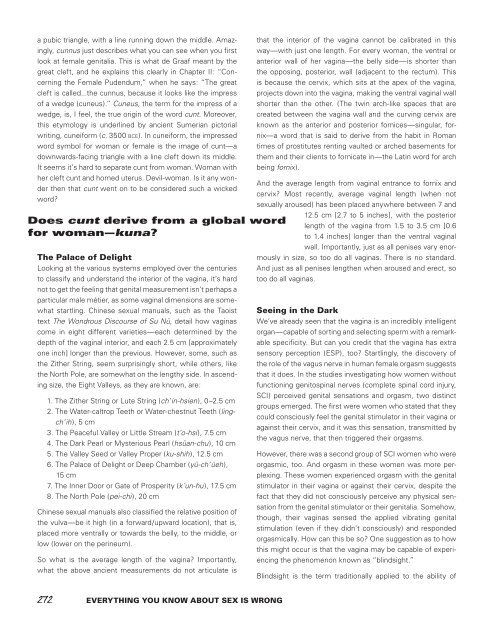You also want an ePaper? Increase the reach of your titles
YUMPU automatically turns print PDFs into web optimized ePapers that Google loves.
a pubic triangle, with a line running down the middle. Amazingly,<br />
cunnus just describes what you can see when you first<br />
look at female genitalia. This is what de Graaf meant by the<br />
great cleft, and he explains this clearly in Chapter II: “Concerning<br />
the Female Pudendum,” when he says: “The great<br />
cleft is called...the cunnus, because it looks like the impress<br />
of a wedge (cuneus).” Cuneus, the term for the impress of a<br />
wedge, is, I feel, the true origin of the word cunt. Moreover,<br />
this etymology is underlined by ancient Sumerian pictorial<br />
writing, cuneiform (c. 3500 b c e ). In cuneiform, the impressed<br />
word symbol for woman or female is the image of cunt—a<br />
downwards-facing triangle with a line cleft down its middle.<br />
It seems it’s hard to separate cunt from woman. Woman with<br />
her cleft cunt and horned uterus. Devil-woman. Is it any wonder<br />
then that cunt went on to be considered such a wicked<br />
word?<br />
Does cunt derive from a global word<br />
for woman—kuna?<br />
The Palace of Delight<br />
Looking at the various systems employed over the centuries<br />
to classify and understand the interior of the vagina, it’s hard<br />
not to get the feeling that genital measurement isn’t perhaps a<br />
particular male métier, as some vaginal dimensions are somewhat<br />
startling. Chinese sexual manuals, such as the Taoist<br />
text The Wondrous Discourse of Su Nü, detail how vaginas<br />
come in eight different varieties—each determined by the<br />
depth of the vaginal interior, and each 2.5 cm [approximately<br />
one inch] longer than the previous. However, some, such as<br />
the Zither String, seem surprisingly short, while others, like<br />
the North Pole, are somewhat on the lengthy side. In ascending<br />
size, the Eight Valleys, as they are known, are:<br />
1. The Zither String or Lute String (ch’in-hsien), 0–2.5 cm<br />
2. The Water-caltrop Teeth or Water-chestnut Teeth (lingc<br />
h ’ i h), 5 cm<br />
3. The Peaceful Valley or Little Stream (t’o-hsi), 7.5 cm<br />
4. The Dark Pearl or Mysterious Pearl (hsüan-chu), 10 cm<br />
5. The Valley Seed or Valley Proper (ku-shih), 12.5 cm<br />
6. The Palace of Delight or Deep Chamber (yü-ch’üeh),<br />
15 cm<br />
7. The Inner Door or Gate of Prosperity (k’un-hu), 17.5 cm<br />
8. The North Pole (pei-chi), 20 cm<br />
Chinese sexual manuals also classified the relative position of<br />
the vulva—be it high (in a forward/upward location), that is,<br />
placed more ventrally or towards the belly, to the middle, or<br />
low (lower on the perineum).<br />
So what is the average length of the vagina? Importantly,<br />
what the above ancient measurements do not articulate is<br />
that the interior of the vagina cannot be calibrated in this<br />
way—with just one length. For every woman, the ventral or<br />
anterior wall of her vagina—the belly side—is shorter than<br />
the opposing, posterior, wall (adjacent to the rectum). This<br />
is because the cervix, which sits at the apex of the vagina,<br />
projects down into the vagina, making the ventral vaginal wall<br />
shorter than the other. (The twin arch-like spaces that are<br />
created between the vagina wall and the curving cervix are<br />
known as the anterior and posterior fornices—singular, fornix—a<br />
word that is said to derive from the habit in Roman<br />
times of prostitutes renting vaulted or arched basements for<br />
them and their clients to fornicate in—the Latin word for arch<br />
being fornix).<br />
And the average length from vaginal entrance to fornix and<br />
cervix? Most recently, average vaginal length (when not<br />
sexually aroused) has been placed anywhere between 7 and<br />
12.5 cm [2.7 to 5 inches], with the posterior<br />
length of the vagina from 1.5 to 3.5 cm [0.6<br />
to 1.4 inches] longer than the ventral vaginal<br />
wall. Importantly, just as all penises vary enormously<br />
in size, so too do all vaginas. There is no standard.<br />
And just as all penises lengthen when aroused and erect, so<br />
too do all vaginas.<br />
Seeing in the Dark<br />
We’ve already seen that the vagina is an incredibly intelligent<br />
organ—capable of sorting and selecting sperm with a remarkable<br />
specificity. But can you credit that the vagina has extra<br />
sensory perception (ESP), too? Startlingly, the discovery of<br />
the role of the vagus nerve in human female orgasm suggests<br />
that it does. In the studies investigating how women without<br />
functioning genitospinal nerves (complete spinal cord injury,<br />
SCI) perceived genital sensations and orgasm, two distinct<br />
groups emerged. The first were women who stated that they<br />
could consciously feel the genital stimulator in their vagina or<br />
against their cervix, and it was this sensation, trans mitted by<br />
the vagus nerve, that then triggered their orgasms.<br />
However, there was a second group of SCI women who were<br />
orgasmic, too. And orgasm in these women was more perplexing.<br />
These women experienced orgasm with the genital<br />
stimulator in their vagina or against their cervix, despite the<br />
fact that they did not consciously perceive any physical sensation<br />
from the genital stimulator or their genitalia. Somehow,<br />
though, their vaginas sensed the applied vibrating genital<br />
stimulation (even if they didn’t consciously) and responded<br />
orgasmically. How can this be so? One suggestion as to how<br />
this might occur is that the vagina may be capable of experiencing<br />
the phenomenon known as “blindsight.”<br />
Blindsight is the term traditionally applied to the ability of<br />
272 EVERYTHING YOU KNOW ABOUT SEX IS <strong>WRONG</strong>


